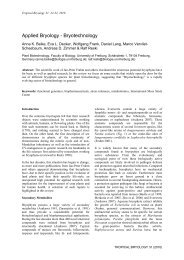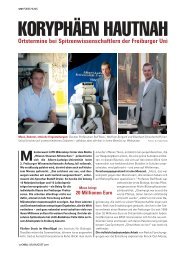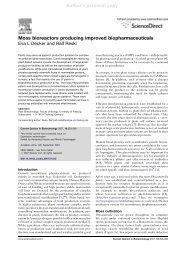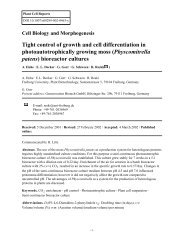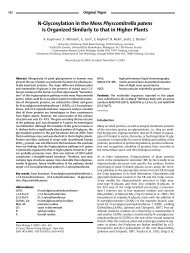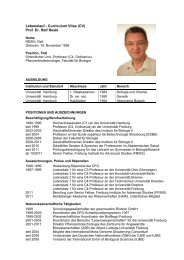Diversification of ftsZ During Early Land Plant Evolution
Diversification of ftsZ During Early Land Plant Evolution
Diversification of ftsZ During Early Land Plant Evolution
You also want an ePaper? Increase the reach of your titles
YUMPU automatically turns print PDFs into web optimized ePapers that Google loves.
160<br />
Fig. 3. Neighbor-joining phylogenetic tree based on 530 amino acid positions. Numbers at the branches result from 1000 bootstrap<br />
resamplings. See text for details.<br />
Because <strong>of</strong> a change in function, it is to be expected<br />
that the region- or site-specific rate <strong>of</strong> acquired<br />
mutational differences will vary, potentially compromising<br />
the outcome <strong>of</strong> phylogenetic analyses.<br />
Interaction and Possible Function<br />
The fact that two divergent gene families with usually<br />
more than one member per family are present in<br />
plants suggests more than one function for FtsZ. The<br />
C terminus <strong>of</strong> bacterial FtsZ is described to interact<br />
with FtsA and ZipA (Ma and Margolin 1999; Yan et<br />
al. 2000; Haney et al. 2001). This short peptide pattern<br />
(Osteryoung and McAndrew 2001) can be found<br />
unambiguously in the extreme C terminus <strong>of</strong> most <strong>of</strong><br />
the FtsZ2 peptide sequences (Fig. 2c), in Physcomitrella<br />
2-1 and 2-2 it contains a mismatch. The pattern<br />
can also be found in most <strong>of</strong> the cy-ng family members,<br />
in some containing a single mismatch as well.<br />
The C termini <strong>of</strong> the Guillardia theta and Mallomonas<br />
splendens sequences do not contain this motif, as is<br />
the case for the FtsZ1 family with one noteworthy<br />
exception: Physcomitrella 1-2 does contain it with<br />
two mismatches. As the C-terminal domain is not<br />
tightly defined by a pattern, it remains speculative to<br />
conclude protein–protein interactions from the presence<br />
or absence <strong>of</strong> a short amino acid pattern.<br />
However, the nearly ubiquitous presence in the <strong>ftsZ</strong>2<br />
and cy-ng family members may suggest an interaction<br />
with other members <strong>of</strong> the plastid division machinery<br />
(e.g., putative ZipA/FtsA homologues or analogues).<br />
Import experiments performed in Physcomitrella<br />
and other organisms demonstrated that FtsZ proteins<br />
encoded by both gene families are subject to plastid<br />
localisation (Osteryoung and Vierling 1995; Gaikwad<br />
et al. 2000; Kiessling et al. 2000). The function <strong>of</strong> the<br />
gene products should be found mainly in plastids for<br />
this reason. On the other hand, when predicting<br />
cleavage sites <strong>of</strong> putative plastid transit signals, FtsZ1<br />
family members generally exhibit a much higher score<br />
than members <strong>of</strong> the FtsZ2 family (Osteryoung and<br />
McAndrew 2001), pointing to a possible difference in<br />
localization or import patterns.<br />
Although involvement in plastid division by means<br />
<strong>of</strong> a ring-like structure has been shown (Vitha et al.<br />
2001), additional functions seem possible, especially<br />
in the light <strong>of</strong> the obviously paralogous (compared<br />
with the cyanobacterial gene) FtsZ1 family. Members<br />
<strong>of</strong> the FtsZ1 family have quite a different genomic<br />
organization compared to the FtsZ2 group in terms<br />
<strong>of</strong> intron/exon structure and they also apparently do<br />
not contain the C-terminal core domain thought to<br />
be involved in interaction with proteins <strong>of</strong> the plastid<br />
division machinery.<br />
As the correct function <strong>of</strong> FtsZ1 in vivo may be<br />
dependent on tight control <strong>of</strong> stochiometry <strong>of</strong> the



